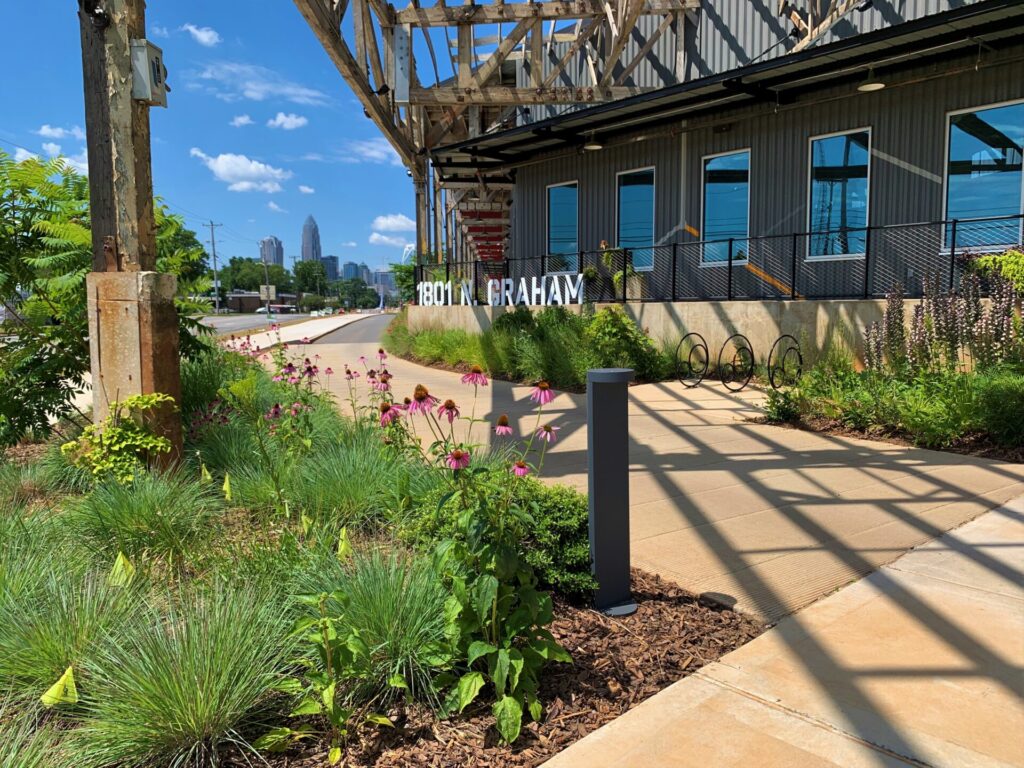By Nancy Duffy
Decades of concrete were peeled back to transform this area into a mixed-use, ecologically valuable area full of native plants.
Camp North End’s landscape may not be something completely different to native plant enthusiasts, but it certainly is unusual in the well-groomed city of Charlotte, North Carolina. Camp North End is a seventy-six-acre development in north Charlotte featuring arts, entertainment, workspace, living space (to come) all in an atmosphere charged with high energy. And the landscape is no different.
Visually exciting, wild yet intentional landscape
The team of people driving the development of this vibrant site asked me to help them realize a wild, yet intentional landscape that is visually exciting and ecologically valuable. Having made many meadows, albeit on a much smaller scale, I took them up on the challenge. Working together over the past three years, we have started something pretty wonderful.
This property has seen the production of Ford Model-T automobiles in the early 1900s and subsequently missiles and vehicles for the US Army. Used as a manufacturing site for one hundred years, the property was covered in concrete. Reimaging this as a people-friendly landscape required a dramatic idea. Damon Hemmerdinger, co-president of ATCO and visionary behind Camp North End, describes the landscape ideal this way:
“Think of a ruined medieval church in the French countryside that has been overtaken by nature. And now imagine that people are being invited back to that place. As part of making it feel safe to its new generation of visitors, that landscape gets trimmed back carefully along walkways but is otherwise left to thrive. This is one of the points of inspiration for Camp North End. It’s not, of course, that easy.”
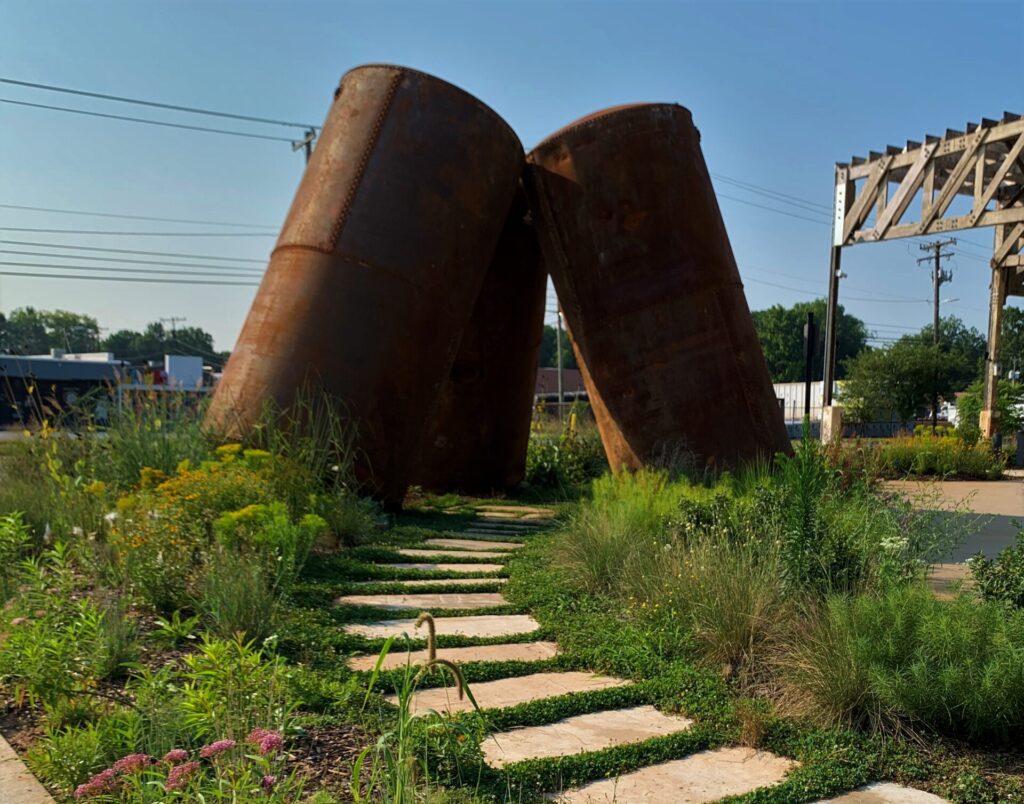
This romantic ideal is underlined by practical considerations and sound horticulture. I refer to the Camp North End landscape as Urban Wild. Urban, as it is set not in the French countryside, but in the city with the Charlotte skyline in the near distance. And wild because we are working toward the goal of naturalistic plantings that support an ecosystem of wildlife as well as enhance the experience of people.
Prairie grasses provide structure to the plantings and contribute food and habitat for birds and insects. Two main grasses are Switchgrass (Panicum virgatum), and Little Bluestem (Schizachyrium scoparium); both of which have deep, fibrous root systems that tolerate and gradually improve compacted clay soil and thrive despite the heat and humidity of the North Carolina Piedmont.
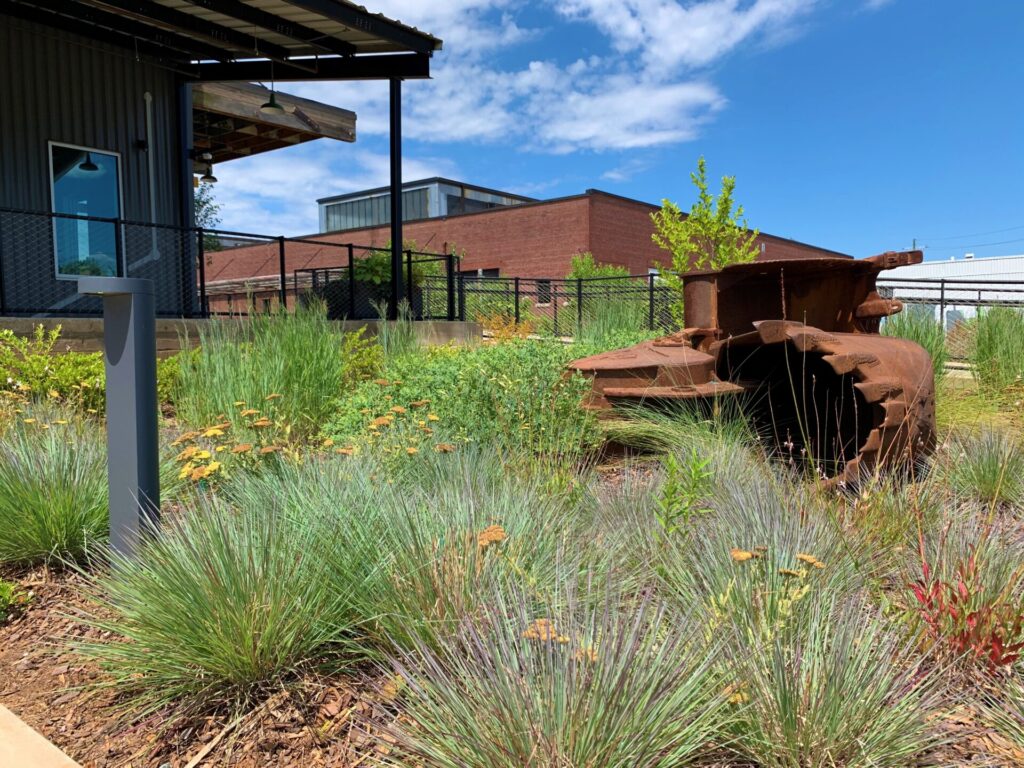
Added to this are forbs that provide pollen and nectar such as milkweeds (Asclepias spp.), Bergamot (Monarda fistulosa), and Cardinal Flower (Lobelia cardinalis). Seed-producing forbs such as coneflowers (Echinacea spp.), goldenrods (Solidago spp.), and Spotted Joe-Pye-weed, (Eutrochium maculatum) are let go to seed for birds and also to reproduce themselves in the landscape.
Woody plants offer food for pollinators and birds and add winter interest to the landscape with colorful fruit. Peppered through the landscape are Red Chokeberry (Aronia arbutifolia), and Winterberry, (Ilex verticillata), and along Graham Street a newly planted line of Winter King Hawthorn (Crataegus viridis ‘Winter King’) are getting established.
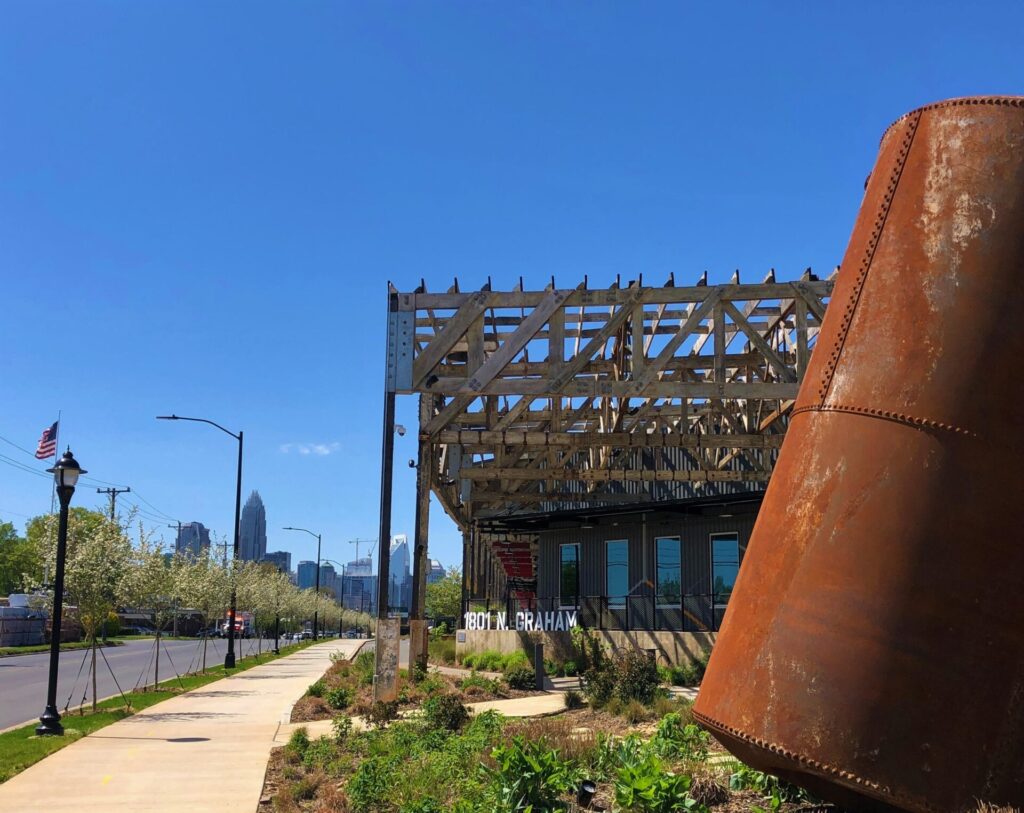
The last piece of the plant puzzle is covering the ground with plants rather than mulch. This season ground-covering plants such Common Blue Violet (Viola sororia) will be planted to knit together the grasses and tall perennials into a quilt of plants.
The movement of tall grasses and splashes of color from flowering perennials offer anyone moving through Camp North End the chance to take a deep breath and relax a little bit.
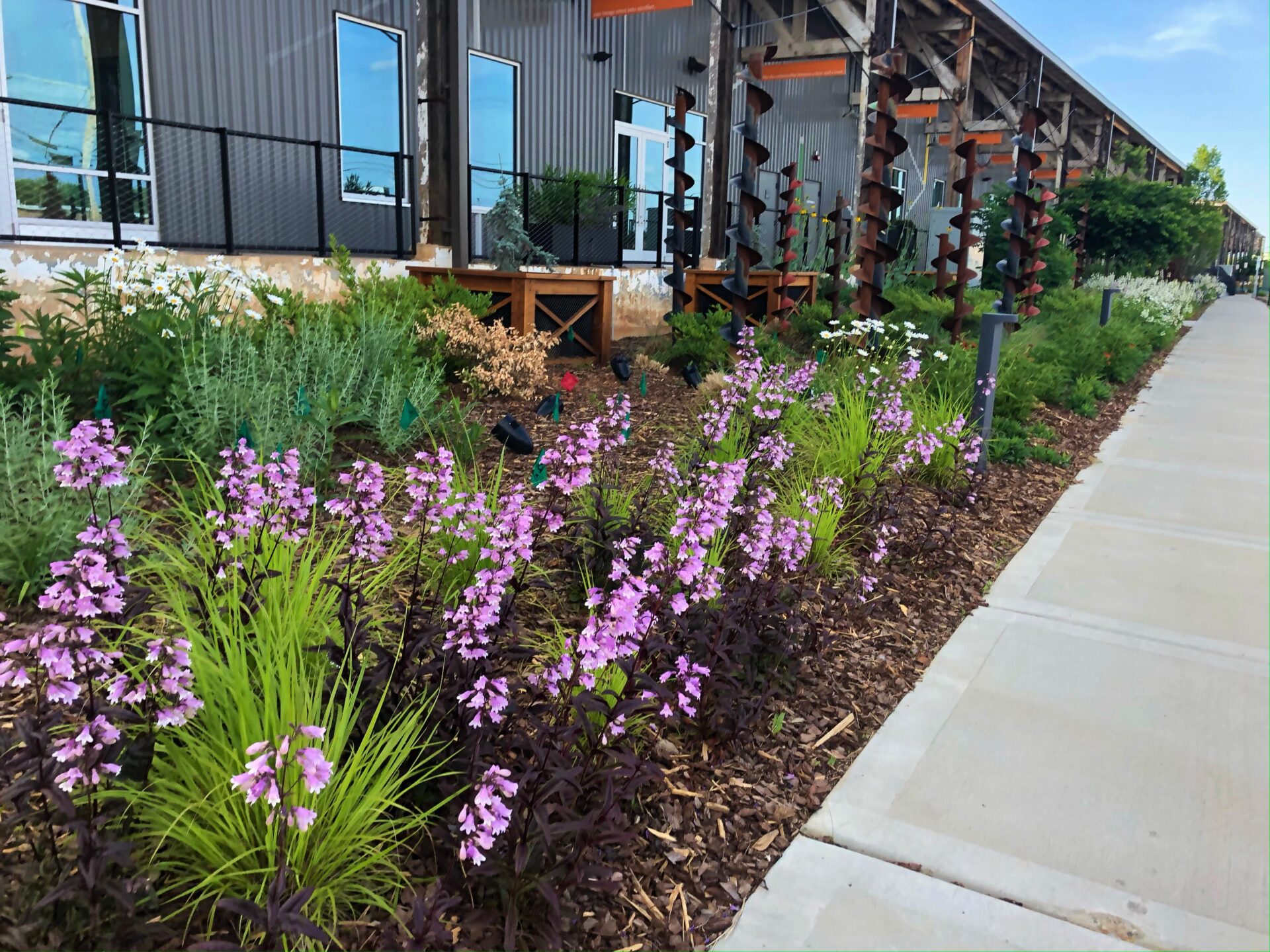
Tough plants crowd out mulch and survive best
These plants were chosen for their aesthetic value, ecological value and for their toughness. Site conditions include compacted clay soil and reflected heat from surrounding pavement. Plants receive no supplemental water beyond the first growing season and neither receive nor need fertilizer. The only amendment initially incorporated at planting was a mix of mostly pine fines and composted organic material: pine fines to create air pockets and organic material to start building healthy soil.
Management of Camp North End landscape is unique compared to most commercial sites, particularly in Charlotte. Banned is the ubiquitous “green meatball” and celebrated are the natural forms that plants take. The hand of the gardener is there if you look closely, but for the most part the goal is to let plants do their thing. It is OK if an ironweed gets tall and flops a bit, but a coneflower laying on the sidewalk will probably get headed back.
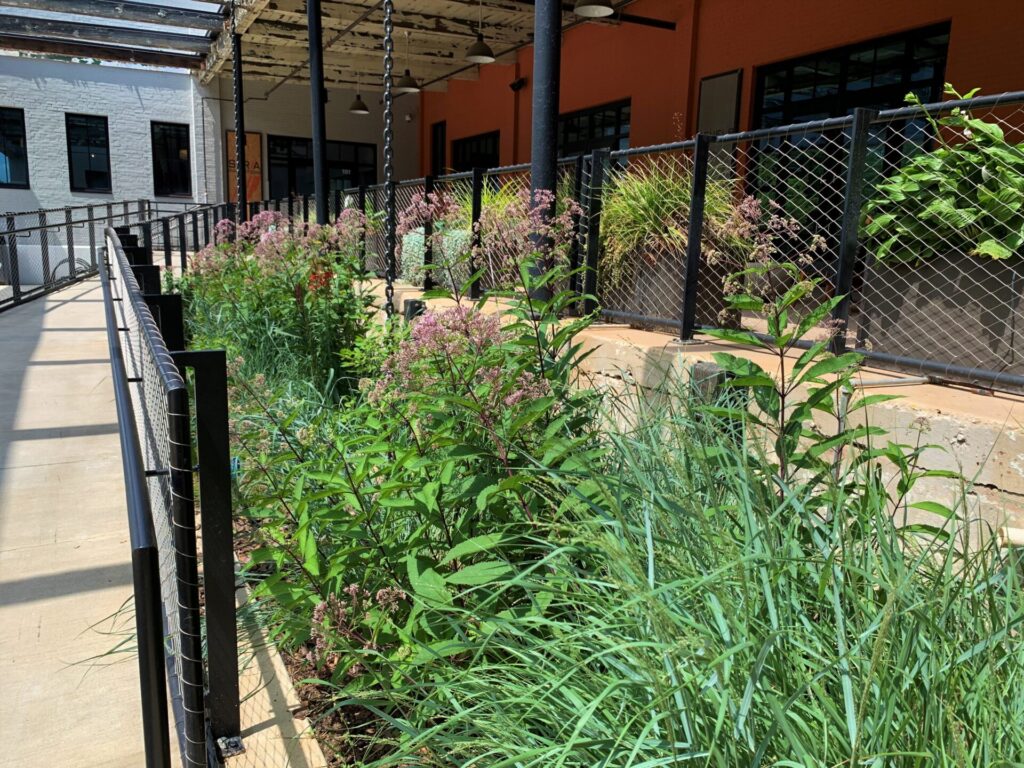
Removing invasive species is a priority and to support their eco-friendly approach Camp North End was temporarily home to a trio of goats, Oats, Barley and Rickey, which put paid to Kudzu and brambles in perimeter areas of the campus. According to Alex Smith, lead Placemaker at Camp North End, “They were very friendly, ferocious eaters, people visited them often, and they became something of a campus mascot.”
Herbicides are used only in rare cases and with great thought to minimizing the impact.
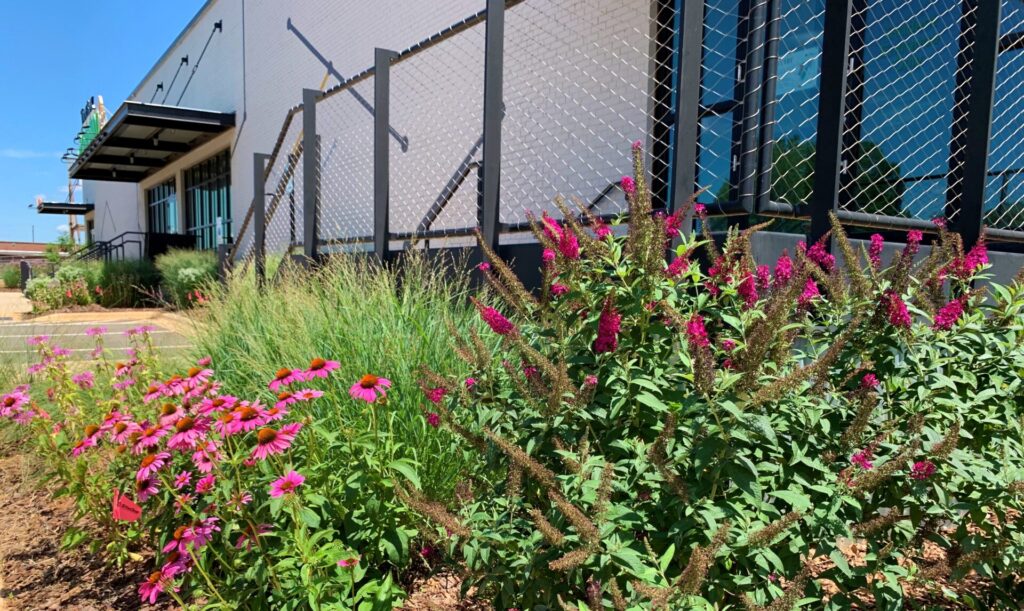
Change in the plantings is not only expected, but welcome. Some plants will thrive and reproduce, popping up in unexpected places, and some plants may die out or be overcome by more vigorous neighbors. Weeds are pulled by hand and if the gardeners cannot readily identify weed versus desired seedling, the plant is left to grow until we know for sure. Whenever possible, new plants are planted during the optimal season and hand-watered during establishment. Pine bark mulch is used to mitigate weeds and hold in moisture but will hopefully be replaced with plants as the groundcovers get growing.
Managing this landscape is a learning experience for everyone who has a hand in it. Krystle Pasion, Vice President Asset Management of ATCO, has been an integral player in making the landscape come to fruition. Krystle’s commitment and enthusiasm is infectious:
“The beauty of Camp North End’s landscape is enjoyed by all but little is known to most about the intentional design and care of the wild landscape, even to those who are on-site daily. To kick-off the growing season, we held a gardening party and extended the invite to the larger Camp North End team, including property management, engineers and the development team. We learned how to identify woody plants, weeds, ground cover and the significance of weed pressure. We pruned, we weeded (with trepidation!), we gardened – and at the end of the day we were all left with a deeper appreciation and understanding of our landscape and the level of care required to reach sustainability.”
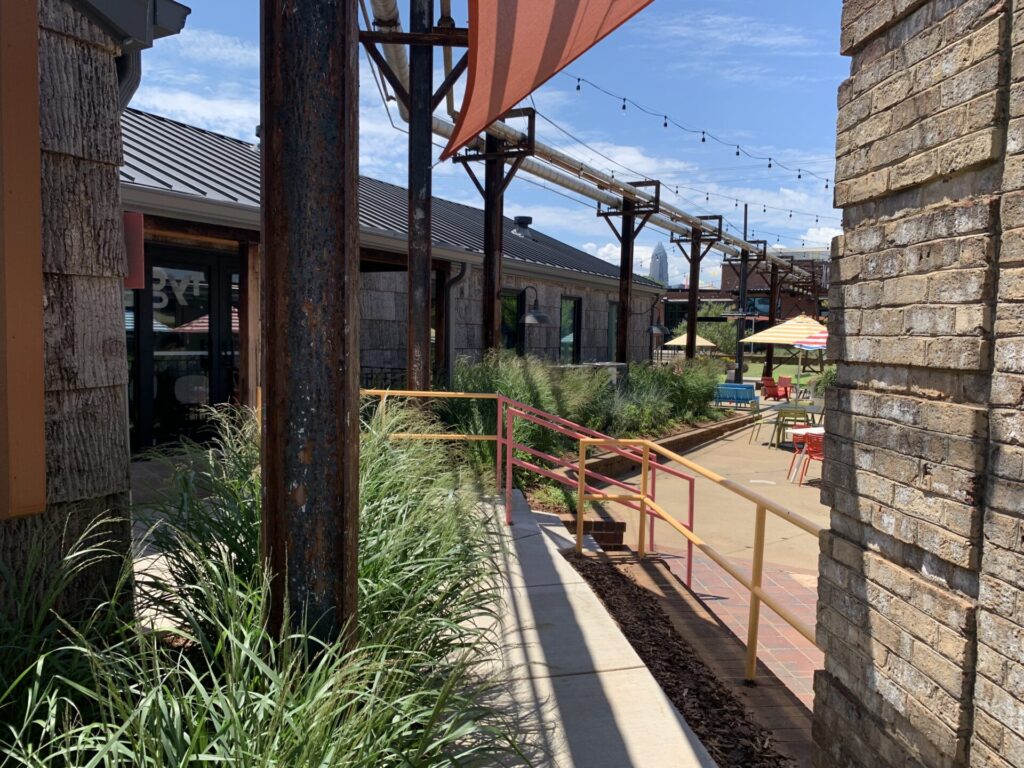
Lo-to-no-irrigation, pollinators, natives
This seventy-six-acre property, with its long history, is being reimagined as a creative hub for businesses large and small, and is being developed with the health and well-being of the Camp North End community. When asked about what’s coming next, Alex Smith, Camp North End, reports:
“In this second phase, the landscape will continue to carry out our commitment to the health and well-being of the businesses and visitors of Camp North End. We are creating safer streets, sidewalks, walking paths, and porches that are human-centered, and no longer car, train or “big rig”-centered. As we peel back decades of concrete and asphalt that were in service to shipping and receiving, we’ll replace that with “green” spaces for people. These green spaces, designed by Nelson Byrd Woltz Landscape Architects, have been placed in, on, and around our buildings with an abundance of plants, trees, low-to-no irrigation, pollinators, and native species. We are thrilled with what is underway and can’t wait to have the public exploring and enjoying these spaces later this spring.”
Camp North End offers a fun and unique experience to all visitors, and anyone who enjoys native plants will no doubt appreciate what this forward-thinking team is bringing to life in Charlotte.
By Nancy Duffy
Native Plant News – Summer 2022

Nancy Duffy is the owner of Muddy Boots Garden Design, based in Asheville, NC. For nearly twenty years she has been designing gardens that reflect the people who will inhabit them; combining beauty, function, and good horticulture. Over the last decade Nancy has increasingly focused on natural planting styles and has done many meadow and woodland designs. She lives and gardens with her husband Dennis and a crew of critters on four acres in the Blue Ridge Mountains.
